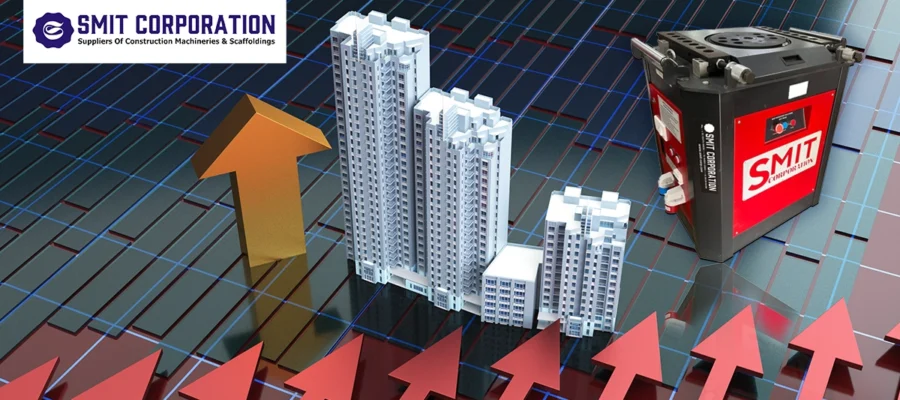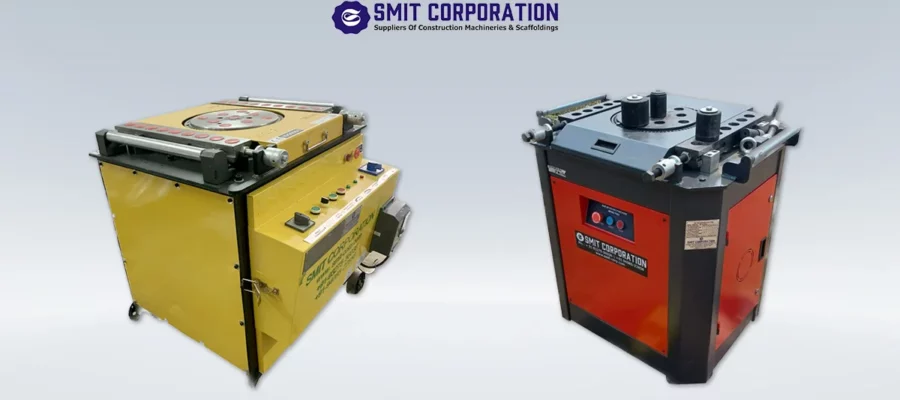
- March 18, 2024
- By: smitcorp
- in: Bar Bending Machine, bar processing machine, Construction Equiments

Bar Bending Machine has been around since the middle of the 20th century. In the past, manual bar bending was the backbone of construction methods, requiring a lot of trained work and conventional equipment. Rebar shapes and dimensions used to vary as a result of human error in manual bar bending processes. Workers doing manual bar bending operations were highly exposed to repetitive motion injuries, such as musculoskeletal disorders (MSDs). Although this manual method worked well for smaller projects, it became unworkable as construction projects became more sophisticated and large-scale. Knowing the history of manual bar bending helps one to recognize the need for a more sophisticated and effective method in the future.
The invention of automatic bar bending machines marked a sea change in the development of bar bending procedures. By adopting cutting-edge technologies, Smit Corporation became an innovator and transformed the effectiveness and accuracy of rod bending. Automation’s integration signaled a fundamental change in the construction industry, reducing procedures and raising the bar for efficiency.
The construction industry has always been adaptable, using new technology and practices to increase productivity, safety, and quality. Significant breakthroughs are being made in bar bending technologies. As projects get more complex and deadlines tighten, advancements in this critical process become increasingly important. Let’s look at some of the upcoming trends influencing the landscape of bar bending technologies.
A key tool in molding the reinforcing bars used in concrete buildings is the bar bending machine. Automation and robotics developments in recent years have completely changed these devices. More accuracy and speed are what bar bending machines will need to succeed in the future. Imagine a situation where a single operator uses user-friendly interfaces to handle many machines at once, cutting down on human error and increasing output. Predictive maintenance could be made possible by integration with artificial intelligence, guaranteeing little downtime and optimum output. Some of the advancements in bar bending machine technology are mentioned below:
Automation and Robotics: More advanced automation and robotics will probably be included in future bar bending machines. One example of this would be fully automated bending procedures, in which machines are designed to handle various bar diameters and bend configurations with the least amount of human involvement possible. Material handling, inserting bars into the machine, and output management might all be done using robotic arms.

AI and Machine Learning: Bending processes can be optimized by incorporating machine learning (ML) and artificial intelligence (AI) technologies. These systems can optimize characteristics such as bend angles, sequences, and material utilization by analyzing data from previous bending projects. AI might make predictive maintenance possible, which would cut downtime and increase the overall efficiency of the equipment.
IoT Connectivity: In the future, bar bending machines will most likely be IoT-enabled, allowing for remote monitoring of machine performance and operations. IoT connectivity enables predictive maintenance, energy usage monitoring, and integration with construction management software for seamless project coordination.
3D Bending Capabilities: While 2D bending (in-plane bending) is widespread, future machines may include 3D bending skills, allowing for more complicated shapes and structures to be created without operator intervention. This could transform the design options for reinforced concrete structures.
Energy Efficiency: Future bar bending machines will prioritize energy efficiency and sustainability. With increasing worries about energy usage and environmental effects, future machines may prioritize energy efficiency. This could include the making of more efficient motors, hydraulic systems, and power management technology.
Augmented Reality (AR) and Virtual Reality (VR): These technologies can be connected to give operators real-time visualizations and directions. This can speed training, eliminate errors, and boost overall productivity.
The innovations in bar bending machine technology will benefit construction business owners by saving time and overall project cost. The major advantages are Reduced Labor Costs, Increased Operational Efficiency, Minimized Error and Rework Costs, Faster Bending Speed, and Enhanced Productivity.
In a nutshell, the technology of bar bending machines has a bright future ahead of it, with a focus on increased user experience, automation, connectivity, and sustainability. The construction industry is constantly demanding faster, safer, and more efficient construction procedures, and these developments will be essential in fulfilling those needs.
The state-of-the-art automatic bar bending machines from Smit Corporation will improve your construction processes. Discover our cutting-edge solutions at Smit Corporation and set out on a path toward accuracy, effectiveness, and the construction industry’s future. Transform your projects with Smit Corporation, where the shift from innovative processes shapes the construction industry.



We, Smit Corporation established in the year 2018 at Surat and being ISO certified, we are instrumental in providing innovative construction machinery and proficient after sales services & spares at the affordable price, that would contribute to revolutionize the construction equipment segment in India. We are the authorized dealer of Wacker Neuson Equipments – a leading global manufacturer of light and compact equipments, offering Indian customers a comprehensive product and service range. Along with it, we deal in all kind of Construction Machinery like Bar Bending Machines, Bar Cutting Machines, Tamping Rammer, Concrete Vibrators, Suspended Platforms & Walk Behind Rollers. We’ve served many prestigous government projects & private projects as well. Backed by the expert team having vast technical knowledge & experience in customer relationship, We are sure to pave you a smooth road to success in any construction project.
2. 7/1165 B, Asarawala Estate, B/h Hamd Park, Rampura, Surat, Gujarat, India – 395003
Monday – Saturday : 9:30 am – 6.30 pm
Connect Socially